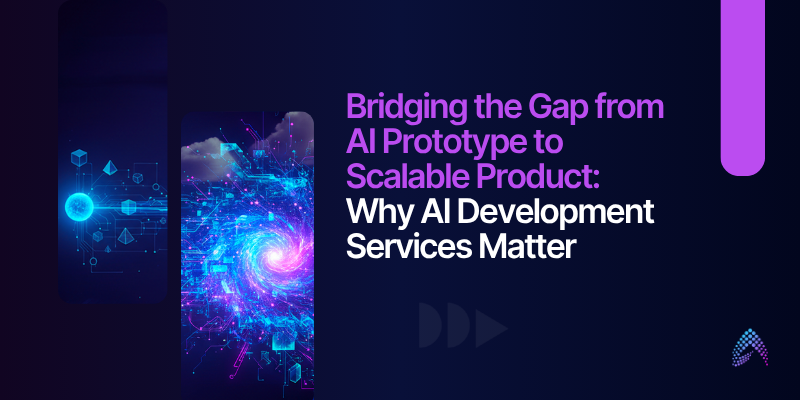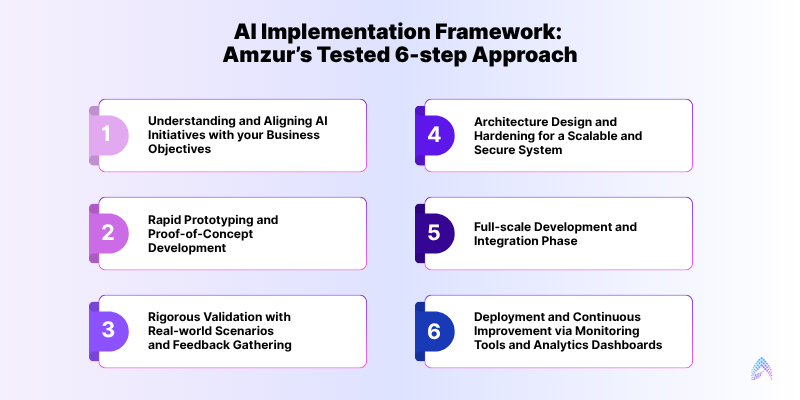Bridging the Gap from AI Prototype to Scalable Product: Why AI Development Services Matter

The evolution of AI and Gen AI is like magic wands in a Startup business owner’s hands. Everything is being done at lightning speed, including ideation, prototyping, and more, with no prior coding skills required.
It’s now common for an AI startup to spin up a proof-of-concept in days using AI coding assistants or no-code tools. These rapid prototypes are absolutely fantastic for fundraising and market validation, showcasing a vision to investors and early customers.
However, many founders quickly encounter a harsh reality: the gap between a quick AI prototype and a production-ready system is enormous. In fact, while 80% of executives believe AI is vital for business, only about 20% of companies have successfully scaled AI beyond pilot projects [CIO].
This article highlights the challenges of scaling AI solutions and how a hybrid approach, combining AI development services with traditional software engineering, can bridge the gap from prototype to product.
Rapid Growth of AI Prototyping in 2025
Imagine a scenario: you have a groundbreaking idea and use an AI tool to generate code for a demo in minutes. It works well enough to impress stakeholders. This is the new norm. AI platforms excel at ideation, rapid prototyping, and proof-of-concept development, allowing even lean startups to create functional demos almost overnight.
These prototypes are perfect for initial validation and they show what’s possible, fast. But behind the scenes, the code and structure of a quick AI-generated prototype can be shaky and become a roadblock.
AI often prioritizes making something work right now over making it work well long-term. As a result, the very speed that makes AI prototyping alluring also hides a dangerous trap: technical debt.
One recent analysis found that teams using AI prototyping tools without proper guardrails experienced 3× more production delays and spent 40% more on cloud costs due to inefficient architectures. [IBM]
Rapid prototypes can give a false sense of progress. It’s easy to mistake a prototype for a product, especially when it looks polished on the surface. But many startup founders have learned the hard way that a demo is not a sustainable solution. AI prototype to production has become a real challenge for many startups and SMBs with limited technology skills and unclear use cases.
Speed isn’t everything in engineering; more code, produced faster, can mean more problems if quality is compromised. AI-generated code is often not production-ready, lacking optimization for security, clarity, and resilience. This is the peril of rapid AI prototyping: without careful planning, you might win the sprint only to stumble in the marathon of product development.
Learn about the true cost of AI implementation in 2025.
Why AI Prototypes Fail to Scale Without AI Development Services
88% of AI pilots fail to reach production: CIO News
The pain point for AI-driven startups today is scaling that prototype into a reliable product. After the excitement of a successful demo, teams often hit “post-prototype paralysis”.
All the tough questions come flooding in:
- Is the system architecture solid?
- Will it handle real-world user loads?
- Is our data secure and compliant?
- How do we monitor and maintain this AI service 24/7?
This is where many AI prototype projects stall. The prototype, built quickly to prove a concept, usually lacks proper architecture, security protocols, robust testing, and maintainable code structure. These are the benchmarks of enterprise-grade software, and they’re non-negotiable for production.
Security is a prime concern. A prototype might use dummy/ synthetic data and minimal protections, but a production system needs stringent authentication, encryption of data, compliance with regulations, etc.
Similarly, a quick AI-built app might not be designed for scalability, perhaps it works for 10 test users, but will it perform for 10,000 or a million? Often, the answer is no, not without significant re-engineering. Technical debt accumulates when shortcuts in the prototype aren’t addressed; if you try to scale on top of that shaky codebase, you risk crashes, breaches, and costly rebuilds.
In short, many AI startups struggle here: going from a cool demo to a robust, user-ready product is like jumping a chasm. Without a plan, you end up with what we call the “last-mile problem.” The prototype works, but the distance to a full product feels insurmountable. This is where AI implementation partner comes into the picture to resolve AI scalability problems.
Combining AI Speed with Traditional Software Engineering: A Hybrid Approach
So how can organizations prepare for this shift from AI prototype to production? Innovative businesses are adopting a hybrid approach: leveraging AI for what it does best, rapid innovation, while partnering with experienced AI development teams to fortify and scale the solution.
This hybrid strategy gives you the best of both worlds. You get AI’s efficiency and speed up front, then human experts ensure proper architecture, security, and performance optimizations are in place for the long run.
Crucially, this approach helps avoid the technical debt trap. Rather than piling hack upon hack until the whole thing collapses, you address weaknesses early. Think of it like building a house: AI can quickly sketch the blueprint and even assemble a rough structure, but you still need a master builder to reinforce the foundation, wire the electricity safely, and pass the building codes.
As technical commentators have noted, AI-coded solutions still require human oversight and refinement, including code reviews, adherence to best practices, and rigorous testing remain essential.
The Role of AI Development Services in Scaling Solutions
This is where AI development services come into play. Bridging the prototype-to-production gap often requires expertise and bandwidth that a small startup team doesn’t have. AI consulting companies and AI solutions providers specialize in this bridge-building. They offer AI implementation services that take a promising prototype and methodically turn it into a full-fledged product.
How do they do this?
First, by performing in-depth code and architecture reviews of the AI-generated prototype. Then, by applying software engineering best practices: designing a scalable architecture, fortifying security, refactoring code for maintainability, setting up databases and cloud infrastructure, and implementing continuous integration and deployment pipelines.
As an AI solutions provider, Amzur understands that successful AI products need more than a clever algorithm. They need a resilient backend, a well-thought-out data strategy, user-friendly design, and ongoing support. By partnering with an expert team, startups can avoid missteps and scale their AI solutions smoothly.
The goal is not to slow down innovation, but to anchor it on solid ground. With the right guidance, a startup can go from a demo that wows a few people to a reliable service that delights thousands or millions.
A detailed guide on how to scale AI in 10 easy steps.
Best AI Implementation Framework: Amzur’s Tested 6-step Approach

To systematically guide this journey, Amzur employs a six-step AI development framework that takes startups from initial idea to production success.
Step 1 focuses on understanding and aligning with your business objectives. Amzur begins by assessing your AI maturity and the specific problems you aim to solve, ensuring any AI initiative fits your core strategy and delivers real value.
Step 2 is rapid prototyping and proof-of-concept development. Here, Amzur leverages cutting-edge AI tools to build a quick prototype or model that demonstrates the concept.
Step 3 involves rigorous validation and feedback gathering. The prototype is tested with real-world scenarios (or real data) to evaluate its performance and identify any gaps. Amzur’s team collects feedback from end-users, domain experts, and technical reviewers to verify that the solution meets the necessary requirements and to pinpoint what needs improvement before scaling up.
In Step 4, Amzur moves into architecture design and hardening. This is where the provisional prototype is transformed into a blueprint for a scalable, secure system. The team addresses questions of system architecture, data pipelines, security protocols, and integration points with other software.
Step 5 is the full-scale development and integration phase. Amzur’s engineers refactor and rewrite portions of the prototype as needed, applying robust coding standards to produce maintainable, efficient code. We integrate the AI solution into the broader application or cloud environment, with thorough testing (unit, integration, security testing) at each step.
Step 6 is deployment and continuous improvement. Amzur assists in deploying the AI product to production, implementing monitoring tools and analytics dashboards to track its performance in the wild. Importantly, this last step also includes training your team and setting up processes for ongoing maintenance, ensuring that as your user base grows, the AI system continues to run smoothly and can be updated or scaled with minimal friction.
Learn more about our comprehensive and result-driven AI development framework.
Conclusion: Turning AI Demos into Lasting Impact
In today’s fast-paced tech landscape, AI startup founders must balance vision with execution. Rapid prototypes showcase vision; they prove that your AI idea has merit. But execution is what turns that idea into a reliable product and a viable business. The struggles of AI-built startups in scaling up are very real, yet they’re surmountable with the right strategy.
By acknowledging the gap between an AI-generated prototype and an enterprise-ready solution, and by investing in the processes and partnerships to bridge that gap, companies can avoid being part of the failure statistics and instead join the ranks of those successfully harnessing AI at scale.
Let Amzur help you build a successful and scalable AI product. Get in touch with our AI implementation expert team today. If you are searching for a trusted AI services provider in the USA, Amzur helps you with a custom strategy and a winning AI implementation framework.
Frequently Asked Questions
Why shouldn’t I ship an AI prototype as-is?
Quick demos lack security, scalability, and clean code. Shipping them unrefined risks crashes, breaches, and soaring tech debt.
How do AI implementation services boost scaling?
Specialists refactor code, design robust architecture, and automate CI/CD so your AI handles real-world loads without rework.
What is the technical debt trap in AI?
Shortcuts in early prototypes pile up hidden flaws; later fixes cost time and money. Expert engineering “pays down” that debt early.
How does Amzur’s framework protect my startup?
We prototype fast, then apply six disciplined steps—validation, architecture, hardening, deployment, monitoring—to deliver production-ready AI.
What is AI Development Services?
AI development services involve end-to-end expert help—strategy, prototyping, engineering, deployment, and support—turning AI ideas into stable, scalable products.

Director ATG & AI Practice




